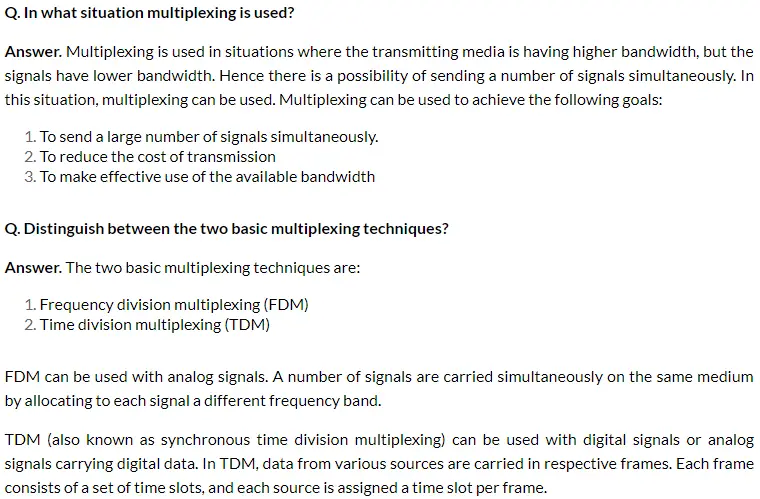In order to transmit a large number of signals from one location to other, multiplexing is used. Communication channels are costly so it is not economical to use separate channel per signal. Signals can be transmitted over a single communication channel by either dividing the time slots between various signals and transmitting it in turns (time sharing) or by assigning different bandwidth to each signal and transmitting at once (frequency sharing).
Read More: Frequency Division Multiplexing
Time Division Multiplexing
In time division multiplexing(TDM), a number of channels are interleaved in time into a single digital system. Each channel input is periodically sampled and assigned a certain time slot. At the transmitting end, input channels are sequentially sampled by a switch resulting in a train of amplitude samples. The coder then sequentially converts each sample into a binary code using analogue to digital conversion techniques. TDM can be used with digital signals or analog signals carrying digital data.
In TDM, the channel/link is not divided on the basis of frequency but on the basis of time.
The Coder output is the string of binary digits representing channel 1, channel 2, and so on. These channels are combined with framing bits for MUX/DEMUX synchronisation.

The smallest group of bits containing at least one channel from each signal plus framing bit is known as a frame.
The framing bits forms a repetitive pattern i.e. combine with channel bits within the MUX. DEMUX then successfully recognise the contents of framing pattern to distribute incoming bits to the proper channel.
- If a MUX assigns each channel a time slot equal to 1 bit, the arrangement is known as bit interleaving.
- If a MUX assigns each channel a time slot equal to one word, the arrangement is known as word interleaving.
A buffer storage is necessary for word interleaving to accumulate a group of bits from each channel while waiting for transfer to the MUX. This type of interleaving is used for word oriented data.
If a fixed relationship exists between the Channel rates, the frame length is determined by a lowest common multiple of incoming channel width.
1. Synchronous Time Division Multiplexing
It Periodically generates the frame consisting of a constant number of time slots, each time slot of constant length. A starting delimiter (flag) is used for frame synchronisation which is needed to differentiate One Frame from next frame. Because of a flag, individual time slots can be identified by position within a frame.

Advantages
- An order is maintained.
- No addressing information is required channel capacity should be large.
Disadvantages
- High bitrate is required.
- If no input signal is present at one channel since a fixed time Slot is assigned to each channel, that time slot for that channel does not carry any information and there is wastage of bandwidth.
2. Asynchronous Time Division Multiplexing
When data from different channels is not available at fixed predetermined rates rather it is available at the rates which are statistically determined, then their multiplexing is known as asynchronous time division multiplexing or statistical time division multiplexing.
In this, data may send from a channel at any time and for different duration. In this type of multiplexing, time slots are not fixed i.e. the slots are flexible. The clocks of MUX and DEMUX are not synchronised whether the channel of incoming data is identified by an address that included in the frame.
In asynchronous TDM, slots are not predefined, the slots are allocated to any of the channels that have data to send.

Advantages
- Code utilisation of communication channel.
- TDM circuitry is not very complex.
- Communication link of low capacity is used.
- The problem of crosstalk is not severe.
- Full available channel bandwidth can be utilized for each channel.
- intermodulation distortion is absent.
Disadvantages
- Frames have different sizes
- Requires buffer
- Address information is needed
Excercise
Q. Why is sync pulse required in TDM?
Answer. In TDM, in each frame time slots are preassigned and are fixed for each input sources. In order to identify the beginning of each frame, a sync pulse is added at the beginning of every frame.




It will be really helpful if u will also explain the reason behind the advantages and disadvantages.
Alhamdulillah Rabbi Al Amin
Thanks
Well explained so happy with the answer.
Thank you Abdussamad.
very good